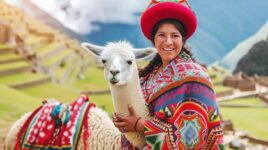
How Does Peru Celebrate Christmas
How does Peru celebrate Christmas? Christmas in Peru is a time of great joy, celebration, and rich traditions. From the Andes to the Amazon, this holiday is deeply rooted in Peruvian culture and holds a special significance for its people. In this article, we will explore the unique ways in which Christmas is celebrated in Peru, from traditional customs to modern festivities.
The significance of Christmas in Peruvian culture goes beyond just a religious holiday. It is a time when families come together, communities unite, and the spirit of giving and sharing is at its peak. The colorful and vibrant celebrations reflect the country’s rich history and diversity, making it a truly magical time of year.
Throughout Peru, you will find traditional Christmas decorations adorning homes, streets, and public spaces. These decorations often include nativity scenes, known as “pesebres,” handmade ornaments, festive lights, and vibrant displays that capture the essence of Peruvian culture.
Christmas Eve holds special importance in Peru, with unique customs and traditions that set it apart from other countries. From Midnight Mass to festive gatherings with loved ones, Peruvians embrace this evening as a time for reflection, gratitude, and unity.
In addition to these shared traditions, different regions of Peru have their own distinct Christmas customs. From the highlands to the coast, each area brings its own flavor to the holiday season through music, dance, food, and rituals that are deeply rooted in local culture.
Peru’s cuisine takes center stage during Christmas with an array of traditional dishes that are prepared and enjoyed during this festive time. From “paneton” (sweet bread) to “chicha morada” (a sweet purple corn drink), Peruvian Christmas cuisine reflects both indigenous and Spanish influences.
As we delve deeper into the diverse ways in which Peru celebrates Christmas – from lively markets and fairs to religious ceremonies and processions-it becomes clear that this holiday holds a special place in the hearts of all Peruvians. Stay tuned as we take you on a journey through the unique and festive spirit of Christmas in Peru.
The Significance of Christmas in Peruvian Culture
Christmas holds a significant place in Peruvian culture, blending ancient indigenous traditions with Spanish colonial influences. The holiday is a time for family and community, marked by both religious and secular celebrations that highlight the country’s diversity and heritage.
One of the key elements of Christmas in Peru is the Nativity scene, or “pesebre,” which is often displayed in homes and public places throughout the country. These elaborate scenes typically feature clay figurines depicting Mary, Joseph, baby Jesus, and other characters, surrounded by Andean landscapes or traditional Peruvian settings. In addition to the typical Nativity figures, it’s not uncommon to find local animals representing the region where the scene is being displayed.
Another important aspect of Christmas in Peru is the celebration of “La Noche Buena,” or Christmas Eve. This is when families come together for a festive meal and to exchange gifts. As part of their celebrations, many Peruvians attend midnight mass at local churches to commemorate the birth of Jesus. After mass, fireworks light up the sky as families continue their merrymaking into the early hours of Christmas Day.
During this festive season, Peruvians also honor their ancestors through a tradition known as “Misa de Aguinaldo.” This involves attending early morning masses in the days leading up to Christmas Eve to pay respect to those who have passed away.
In different regions of Peru, Christmas traditions may vary slightly based on local customs and beliefs. For example, in Andean communities, there may be rituals involving offerings to Mother Earth (Pachamama) as well as traditional music and dance performances that add a unique flair to the holiday celebration.
Overall, Christmas plays an integral role in Peruvian culture, serving as a time for unity, reflection, and joyous revelry among all who partake in its rich traditions. Whether through religious ceremonies or vibrant street festivals, Christmas in Peru underscores the country’s deep-rooted sense of community and reverence for its diverse cultural heritage.
- Traditional dishes such as “panettone” (a sweet bread with dried fruits), “chocolatada” (hot chocolate served with panetón), and “turron” (a nougat-like candy)
- Elaborate processions featuring statues of patron saints
- Modern activities include concerts, parades, light displays, and visits from Santa Claus
- Christmastime crafts markets selling handmade decorations and gifts
- Local music ensembles performing traditional Andean carols
Traditional Christmas Decorations in Peru
Peru is a country rich in traditions and customs when it comes to celebrating Christmas. One of the most important aspects of the holiday season in Peru is the traditional Christmas decorations that adorn homes, streets, and public spaces throughout the country. These decorations are not only visually beautiful but also carry deep cultural and religious significance for the Peruvian people.
One of the most iconic Christmas decorations in Peru is the nativity scene or “pesebre.” The nativity scene is a representation of the birth of Jesus Christ, with figures such as Mary, Joseph, the baby Jesus, angels, shepherds, and animals.
In Peru, families often create elaborate nativity scenes in their homes, using handcrafted figurines made from materials such as clay, wood, or ceramics. These nativity scenes are typically displayed under the Christmas tree or on a dedicated table in the household.
Another common traditional Christmas decoration in Peru is the “arbolito de Navidad,” or Christmas tree. While many Peruvian families now opt for artificial trees, natural trees are also popular in some regions. The Christmas tree is typically adorned with lights, ornaments, and tinsel, and topped with a star or angel. In addition to these traditional decorations, it’s also common to see Peruvian homes adorned with wreaths made of cypress branches and decorated with ribbons and flowers.
In addition to nativity scenes and Christmas trees, Peruvians also decorate their homes with festive lights and lanterns during the holiday season. In urban areas, streets and plazas are often illuminated with colorful lights and decorations to create a festive atmosphere for residents and visitors alike.
Overall, traditional Christmas decorations play a significant role in creating a warm and festive ambiance during the holiday season in Peru. They serve as a visual representation of the deep-rooted cultural and religious traditions that are cherished by Peruvians as they celebrate this special time of year.
| Traditional Decoration | Significance |
|---|---|
| Nativity Scene (Pesebre) | Representation of Jesus’ birth |
| Christmas Tree (Arbolito de Navidad) | Symbols of joy and celebration |
| Cypress Wreaths | Adornment symbolizing eternal life |
How Does Peru Celebrate Christmas Eve?
Peru’s Christmas celebrations are deeply rooted in tradition and culture, making it a unique and festive time of year. One of the most important aspects of Christmas in Peru is the celebration of Christmas Eve, known as “Nochebuena”. This is a night filled with family gatherings, delicious food, and religious ceremonies.
For many Peruvians, Christmas Eve is a time to come together with family and loved ones. The evening often begins with a visit to church for a special Christmas Eve mass, known as “Misa de Gallo” or Rooster’s Mass. This midnight mass is an important part of the Christmas celebration for many Peruvians.
Following the church service, families return home to enjoy a traditional Christmas Eve meal. One popular dish is “pollo a la brasa”, or rotisserie chicken, often accompanied by rice, potatoes, and other traditional Peruvian side dishes. Another beloved holiday treat is “panettone”, a sweet bread that is typically enjoyed with hot chocolate.
After the meal, families exchange gifts and spend time together enjoying each other’s company. In some regions of Peru, it is also common to participate in fireworks displays or light fireworks at home to celebrate the holiday.
Overall, Nochebuena in Peru is characterized by a strong sense of family unity and reverence for tradition. It is a time for reflection, gratitude, and joy as Peruvians come together to celebrate the birth of Christ and the spirit of giving.
| Christmas Eve Traditions in Peru | Details |
|---|---|
| Religious Ceremonies | Misa de Gallo (Rooster’s Mass) at midnight |
| Traditional Meal | Popular dishes include pollo a la brasa and panettone |
| Gatherings and Gifts | Families come together to exchange gifts and enjoy each other’s company |
| Fireworks Displays | In some regions, fireworks are used to celebrate the holiday |
Christmas Traditions and Customs in Different Regions of Peru
The Andes Region
In the Andean region of Peru, Christmas is celebrated with a unique blend of indigenous and Spanish traditions. One of the most famous customs is the Santurantikuy fair, which takes place in the city of Cusco on Christmas Eve. This fair is a colorful and lively event where locals buy traditional Nativity scene figurines to set up their own displays at home. The figures include representations of different aspects of Andean culture, such as llamas, condors, and other local animals.
The Amazonian Region
In the Amazonian region of Peru, Christmas is celebrated with a focus on nature and spirituality. Many communities hold ceremonies that honor the natural world and give thanks for a bountiful year. Additionally, there are unique musical performances and dances that reflect the rich cultural diversity of the Amazonian people.
The Coastal Region
In the coastal region, particularly in cities like Lima and Trujillo, Christmas celebrations have a more urban feel. Residents enjoy elaborate light displays along city streets and plazas, as well as fireworks shows on Christmas Eve. Families gather for large seafood feasts that include traditional Peruvian dishes such as ceviche and tiradito.
The Highlands
In the highland regions such as Arequipa and Puno, traditional Christmas processions are observed with great fervor. These processions often include music, dance, costumes, and religious icons carried through the streets. In addition to these processions, families come together to create elaborate nativity scenes in their homes.
These diverse regional traditions showcase how Peru celebrates Christmas in its various geographic areas. Each region adds its own unique customs and practices to create a rich tapestry of holiday celebrations throughout the country.
Peruvian Christmas Cuisine and Traditional Dishes
Peru is known for its rich and diverse culinary traditions, and Christmas is no exception. During the holiday season, Peruvian families come together to prepare and enjoy a variety of traditional dishes that are a central part of the Christmas celebration.
Some of the most popular Peruvian Christmas dishes include:
- Anticuchos: These are marinated skewers of grilled meat, usually beef heart, that are often served at Christmas gatherings.
- Tamales: Tamales are a staple in Peruvian holiday cooking. They consist of masa (a starchy, corn-based dough) filled with meat, cheese, or vegetables, which is then wrapped in banana leaves and steamed.
- Pollo a la Brasa: This dish, which translates to “grilled chicken,” is a common feature at Peruvian Christmas feasts. The chicken is marinated in a blend of spices and roasted until it develops a crispy skin and tender meat.
- Panetón: This sweet bread, similar to Italian panettone, is a fixture on every Peruvian Christmas table. It is filled with dried fruits and nuts and is often enjoyed with hot chocolate or coffee.
In addition to these classic dishes, many families also prepare their own unique recipes that have been passed down through generations. Each region of Peru has its own distinct Christmas culinary traditions, adding even more diversity to the country’s holiday cuisine.
Given Peru’s strong agricultural heritage and access to an abundance of fresh ingredients, it’s no wonder that food plays such a central role in the country’s Christmas celebrations. Families take great pride in preparing these special dishes as a way of coming together and honoring their cultural heritage.
On Christmas Eve, known as Nochebuena in Spanish-speaking countries like Peru, families gather for a festive meal that often includes multiple courses featuring these traditional dishes. The meal is an opportunity for loved ones to share stories and laughter while enjoying the delicious flavors of Peruvian holiday cooking.
Overall, the combination of traditional recipes and unique regional variations makes Peruvian Christmas cuisine an integral part of how Peru celebrates this joyous holiday season.
Christmas Markets and Fairs in Peru
Peru is a country that celebrates Christmas with great fervor and enthusiasm. One of the key elements of the Christmas celebrations in Peru is the traditional Christmas markets and fairs that pop up all over the country during the holiday season.
These markets and fairs are a central part of the Christmas traditions in Peru, offering a wide variety of goods and activities for people to enjoy. From handmade crafts and artisanal goods to delicious food and live entertainment, these festive gatherings bring communities together in celebration of the holiday season.
One of the most popular Christmas markets in Peru is the Santurantikuy Fair, which takes place in Cusco on December 24th. This fair has been a cherished tradition for centuries, attracting locals and tourists alike with its vibrant display of handcrafted nativity scenes, decorations, and traditional Peruvian gifts. The fair also features an array of local street food vendors selling seasonal delicacies such as tamales, roast guinea pig (cuy), and ponche, a traditional hot fruit punch.
In Lima, the capital city, the Purisima Fair is another well-known Christmas market that takes place in various districts throughout December. This fair showcases a wide range of products including religious items related to the nativity scenes, intricate artisan crafts from different regions of Peru, and typical Peruvian sweets like turrones (nougat) and panetones (sweet bread).
These Christmas markets and fairs are not only places to buy gifts or enjoy delicious food but also serve as venues for live music performances, dance presentations, and other cultural activities such as parades or processions featuring traditional costumes.
For Peruvians, visiting these markets is more than just shopping; it’s about connecting with their cultural heritage and sharing the joyous spirit of Christmas with their loved ones. These festive gatherings play an integral role in bringing communities together to celebrate this special time of year.
| Christmas Market/Fair | Location |
|---|---|
| Santurantikuy Fair | Cusco |
| Purisima Fair | Lima |
The Role of Music and Dance in Peruvian Christmas Celebrations
Peru is a country known for its vibrant and lively culture, and this is especially evident during the Christmas season. One of the key elements that adds to the festive atmosphere in Peru during Christmas is the prominent role of music and dance in the celebrations.
Traditional Peruvian Christmas Music
Music plays a significant role in Peruvian Christmas celebrations, with traditional Andean instruments such as the pan flute, charango, and zampona being commonly heard during this time. In addition to traditional Andean music, Peruvians also enjoy listening to villancicos, which are Spanish Christmas carols that have been part of the country’s musical tradition for centuries.
Folk Dances
Dance is another important aspect of Christmas celebrations in Peru. Traditional Peruvian folk dances, such as the Marinera and Huayno, are often performed during Christmas festivities. These colorful and energetic dances are accompanied by lively music and are a beloved part of Christmas traditions in many regions of Peru.
Chocolatadas Navideñas
One particularly joyous tradition involving music and dance during Christmastime in Peru is the “Chocolatada Navideña.” This tradition involves organizing events where hot chocolate, panetón (a type of sweet bread), and small gifts are distributed to children in underprivileged communities. These events often include live music performances and dancing, adding to the festive spirit and bringing joy to those who participate.
Music and dance play a central role in creating a sense of community and shared celebration during Christmas in Peru. Whether it’s through traditional Andean music, lively folk dances, or joyous community events, these cultural expressions contribute to making Christmas in Peru a truly special and memorable time for both locals and visitors alike.
Christmas Religious Ceremonies and Processions in Peru
Peru is a predominantly Catholic country, and as such, Christmas holds great religious significance in the Peruvian culture. The celebration of Christmas in Peru is deeply rooted in religious traditions and ceremonies that have been upheld for centuries, making it a unique and integral part of the holiday season.
Religious Ceremonies
One of the most important religious ceremonies during the Christmas season in Peru is the “Misa de Gallo” or Midnight Mass, which takes place on Christmas Eve. This mass typically begins at midnight and is attended by families and individuals who come together to celebrate the birth of Jesus Christ. The atmosphere is filled with joy and reverence as worshippers participate in prayers, hymns, and scripture readings that recount the story of the Nativity.
In addition to Midnight Mass, many churches across Peru hold special services throughout the weeks leading up to Christmas. These may include novenas (nine days of prayer), processions, and reenactments of the Nativity scene, all of which serve to deepen the spiritual experience of Christmas for those who participate.
Processions
Another notable aspect of Christmas celebrations in Peru is the colorful and vibrant processions that take place in various cities and towns. These processions often feature elaborate floats carrying images of Mary, Joseph, and baby Jesus, accompanied by music, dance, and traditional Andean instruments. In some regions, such as Cusco or Ayacucho, these processions are particularly grand and draw large crowds of locals and visitors alike.
The most famous procession in Peru during Christmastime is perhaps the “Santurantikuy” in Cusco on December 24th. This traditional market-cum-procession dates back to colonial times and involves artisans from all over Cusco region gathering in the Plaza de Armas to sell their intricate nativity scenes or “retablos,” handcrafted ornaments, textiles, and pottery. The day culminates with a grand procession through the city streets.
Adoration
A key practice during this time is also adoration (adoración) where people visit various churches around Lima between December 16-24th following 9 consecutive nights praying dating back from pre-Columbian times reinforcing Andean revolutionary leader Tupac Amaru II’s conviction: ‘All Peruvians equal before God.’.
Overall Religious ceremonies play a central role in shaping how Peru celebrates Christmas by fostering a sense of community among believers while honoring their faith through these cherished traditions.
Modern Christmas Celebrations and Activities in Urban Areas of Peru
In urban areas of Peru, the celebration of Christmas has evolved to incorporate modern customs and activities while still maintaining the traditional essence of the holiday. The festive spirit is palpable in cities like Lima, where colorful lights and decorations adorn streets and public spaces, creating a joyful atmosphere for both locals and visitors.
One of the most prominent modern Christmas activities in urban Peru is the organization of Christmas parades and festivals. These events often feature vibrant performances, including music, dance, and theatrical presentations that showcase the country’s rich cultural heritage. Families gather to enjoy these spectacles, which add an extra layer of excitement to the holiday season.
In addition to traditional Christmas decorations, many urban areas in Peru have embraced modern lighting displays as a way to celebrate the holiday. Elaborate light installations and themed displays can be found throughout city centers, offering a dazzling visual experience for all who encounter them. From sparkling trees to illuminated sculptures, these decorations contribute to the enchanting ambiance of Christmas in urban Peru.
Furthermore, urban Peruvians have incorporated contemporary customs such as gift exchanges and visits from Santa Claus into their Christmas celebrations. Shopping malls and commercial areas become bustling hubs of activity as people shop for presents and enjoy festive promotions and sales during the holiday season. This modern approach to gift-giving has become increasingly popular in urban settings, adding a touch of commercial flair to Christmas in Peru.
As part of their modern Christmas celebrations, urban Peruvians also participate in various recreational activities that bring communities together. From ice-skating rinks to outdoor markets selling artisanal crafts and traditional treats, there are numerous opportunities for people to engage in seasonal pastimes with friends and family. These activities not only provide entertainment but also foster a sense of unity among city dwellers during this special time of year.
Lastly, many urban areas in Peru host special events like charity fundraisers and volunteer opportunities during the Christmas season. This reflects a growing awareness of the importance of giving back to those in need within the community – a modern interpretation of the age-old spirit of generosity that has always been integral to Peruvian Christmas celebrations.
Overall, modern Christmas Celebrations have created an intersting mixture with typical customs reinforcing Peru’s cultural diversity.
- Parades
- Cultural performances
- Lighting displays
- Gift exchanges
- Recreational activities
Ordered_List:
- Ice-skating rinks
- Outdoor markets
- Charity fundraisers
- Volunteer opportunities
Conclusion
In conclusion, it is clear that Christmas in Peru is a truly unique and festive celebration deeply rooted in the country’s culture and traditions. The significance of Christmas in Peruvian culture is immense, and the holiday holds a special place in the hearts of its people. From traditional decorations to religious ceremonies, from regional customs to modern urban celebrations, Peru has a rich tapestry of Christmas traditions that make it a special time of year for Peruvians.
The way Peru celebrates Christmas Eve is particularly remarkable, with families coming together for a midnight feast and exchanging gifts at the stroke of midnight. This sense of togetherness and unity is at the heart of Peruvian Christmas celebrations, mirroring the country’s strong sense of community and family bonds.
The traditions vary from region to region, with each area putting its own unique spin on the holiday festivities. Whether it’s visiting Christmas markets and fairs or taking part in music and dance performances, each region has its own way of making the season bright.
Of course, no discussion about Christmas in Peru would be complete without mentioning the delicious traditional dishes that are enjoyed during this time. From turkey and tamales to desserts like picarones and panettone, Peruvian cuisine plays a central role in Christmas celebrations.
Overall, the festive spirit of Christmas can be felt throughout Peru, not just in religious ceremonies but also in modern activities and events held in urban areas. The combination of ancient traditions with contemporary customs makes Christmas in Peru a vibrant and exciting time for all who experience it.



